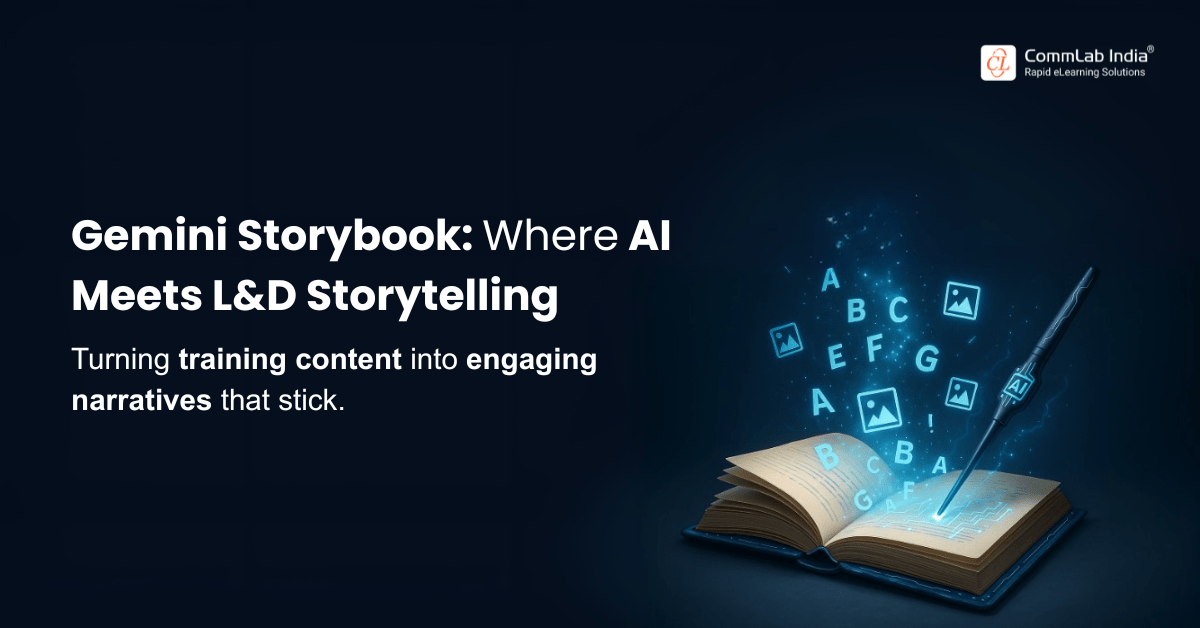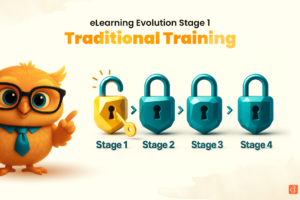
AI Story Generator Explained: Gemini Storybook for L&D
“Storytelling is the most powerful way to put ideas into the world today.” – Robert McKee
In an era where attention spans are shrinking and the demand for engaging content is skyrocketing, artificial intelligence is revolutionizing how we learn and develop. Did you know that the AI market is projected to reach over $1.5 trillion by 2030, with a significant portion dedicated to content creation and personalization?
For Learning & Development (L&D) professionals, instructional designers (IDs), visual designers (VDs), project managers (PMs), and sales & marketing teams attuned to customer trends, this presents an unparalleled opportunity. Enter Gemini Storybook, an AI-powered storybook generator that’s transforming the landscape of learning experiences.
Table of Contents
Why is Narrative so Powerful in L&D?
The human brain is hardwired for stories. From ancient parables to modern-day case studies, narratives make complex information digestible, emotionally resonant, and far more memorable. In fact, a meta-analysis of over 75 studies involving 33,000+ participants found that narrative texts are both easier to understand and more reliably recalled than expository texts.
In L&D, stories do more than entertain—they bridge the gap between abstract theory and practical application. For instance, a study comparing storytelling-narrated videos (SNV) with lecture-narrated videos (LNV) showed that learners exposed to SNV demonstrated not only better retention but also greater transferability—the ability to apply learning in new contexts.
Research in workplace learning shows that when employees are emotionally engaged through stories, they are more attentive, committed, and willing to act on what they learn. Narratives also provide structure and context — characters, challenges, and resolutions—that simplify complex concepts without stripping away meaning. Learners see not just what to do but how to apply it in real-world scenarios.
Behind every great training program is a story that engages, excites, and helps learners truly excel. Let’s see how it works!
As L&D teams look to innovate, leveraging tools like AI-story generators becomes more than just a “nice to have.” They can help scale narrative creation, adapt stories to diverse learners, and integrate storytelling in ways that are backed by science—not just intuition.
What is an AI Story Generator?
An AI story generator is a software tool that uses artificial intelligence, particularly natural language processing (NLP) and machine learning, to create narratives. Based on prompts, keywords, or themes provided by the user, these tools can generate anything from short stories to elaborate plots, often with surprising coherence and creativity.
The best AI short story generator can quickly produce content that would take humans hours, freeing up valuable time for strategic tasks.
How to Find the Best AI Story Generator?
With a growing number of options, identifying the best AI story generator depends on your specific needs. in general, a best-in-class tool will have:
|
Criteria |
What to Look For |
|
Quality of narrative |
Coherence, creativity, character, plot, pacing. It shouldn’t feel too mechanical. |
|
Prompt flexibility |
Ability to accept user prompts for genre, length, audience age, style, voice, themes. |
|
Visual / multimedia support |
Illustrations / images, maybe audio narration, maybe ability to include user photos or drawings. |
|
Customization & control |
Ability to edit, refine, adjust tone/style, revise parts of story. |
|
Speed & ease of use |
Should be quick, not require steep learning; interface should be intuitive. |
|
Multilingual support |
Support for many languages helps widen usability. |
|
Cost / licensing |
Free tiers, paid features; rights/ownership of generated content; ability to share/use the stories. |
Key factors to consider include ease of use, quality of output, customization options, and the ability to integrate with other tools. For L&D professionals, the ideal tool should offer features that support educational content, such as factual accuracy, the ability to generate specific scenarios, and, crucially, the option to create an AI story generator with pictures.
Some of the current top AI story generators (beyond Gemini) include tools like Jasper AI, NovelAI, Writesonic, Canva Story Generator, etc. These differ in whether they are mainly text generation, or also support images, or have “storybook AI” features (text + pictures + layout + maybe audio).
How to Create AI Stories
Creating stories with an AI story generator is remarkably straightforward. Typically, the process involves:
- Providing a Prompt: This is where you feed the AI your initial idea. The more specific and detailed your prompt, the better the output. For example, “Create a story about a new employee navigating company culture, focusing on communication challenges.”
- Defining Key Elements: Specify characters, settings, plot points, themes, and desired tone.
- Generating the Story: The AI processes your input and crafts a narrative.
- Refining and Iterating: You can then edit, expand, or regenerate sections until the story meets your objectives.
This iterative process makes the AI story generator based on prompt incredibly flexible for various content needs.

Storytelling and AI: A Dynamic Duo for Interactive eLearning Experiences
Leverage AI and Storytelling to Create Magic in eLearning!
- The Potential of Storytelling in eLearning
- Tips for Crafting Compelling Stories
- AI in Storytelling
- And More!
How to Use AI to Write a Story (in Practice)
AI’s role in L&D extends far beyond content generation. It can personalize learning paths, provide intelligent tutoring, automate administrative tasks, and analyze learner performance. When it comes to content, AI can:
Here are practical workflows you might follow:
- Scenario brainstorming: Give the AI keywords / topics; let it suggest plot skeletons; pick one and refine.
- Dialogue & character voice: Use AI to generate dialogues; specify which character says what in what tone.
- Scene expansions: Write a brief outline; ask AI to expand certain scenes with vivid detail.
- Multimedia storybooks: If generator supports images / audio, integrate them. For example, provide prompts for illustrations per page.
- Localization / adaptation: Use AI to translate or adapt stories to other languages, children’s levels, or cultural contexts.
- Feedback loops: After initial version, solicit reviews (by peers or learners), then use AI to revise
What is Gemini Storybook?
Gemini Storybook is an AI-powered storybook generator (or “storybook AI”) that combines text, images and audio to produce illustrated books from a user prompt. It is also a kind of ai short story generator based on prompt, but with enriched features (pictures, narration etc.).
How Do You Go from Idea to Story with Gemini Storybook?
Getting started with Gemini Storybook is simple. Here’s a step-by-step guide to move from idea to implementation:
- Access the Platform
- Define Your Objective
- Input Your Prompt
- Select Customization Options
- Generate and Review
- Integrate and Deploy
Built on advanced AI models, Gemini Storybook specializes in generating engaging, visually rich stories that enhance learning, improve engagement, and communicate complex ideas effectively. It’s more than just an AI story generator; it’s a comprehensive storytelling platform.
What are the Key Features of Gemini Storybook?
Here are specific features (based on what is publicly known) of Gemini Storybook:
- Prompt-Based Story Generation: Create custom narratives from simple to complex prompts.
Using Gemini Storybook is intuitive. Here’s a basic workflow:
- Character and Setting Customization: Define protagonists, antagonists, and environments to suit your learning objectives.
- Emotional Tone Control: Set the mood and emotional arc of your stories, from motivational to problem-solving.
- Visual Integration (AI Story Generator with Pictures): Automatically generates relevant images and illustrations to accompany your text, bringing stories to life.
- Story Branching Capabilities: Design interactive “choose your own adventure” style narratives for decision-making training.
- Multi-Language Support: Generate stories in various languages to cater to diverse global learners.
- Export Options: Easily export stories for integration into eLearning modules, presentations, or marketing materials.
How to Get Started with Gemini Storybook?

- Access the Platform: Open the Gemini App or Web and Log in to the Gemini Storybook interface.

- Define Your Objective: What do you want your story to achieve? (e.g., explain a new company policy, illustrate a sales technique, teach a compliance procedure).
- Input Your Prompt: Clearly articulate your story idea, including key characters, plot points, and desired outcomes. For example: “A new sales representative learns to handle customer objections effectively by telling a story of resilience.”

- Select Customization Options: Choose character traits, settings, story length, and opt for image generation. Upload photos, drawings, or documents for personalization. Get a 10-page illustrated story with narration.

- Generate and Review: Let the storybook AI craft your narrative. Review the output and make any necessary edits or refinements. Adjust prompts for tone, length, or style

- Integrate and Deploy: Export your finished story for use in your L&D programs. Send via link, export, or use narration in training sessions.
Tips for Maximizing Your AI Story Generation
Here are some best practices, for Gemini Storybook or any AI story generator / storybook AI, to get better, more meaningful outputs:
- Be Specific with Prompts: Instead of “a bedtime story,” try “a bedtime story for 5-year-olds about sharing, set in a forest, with two talking foxes.” The more detail (tone, characters, setting, moral/theme), the better the AI can produce something usable.
- Use style cues: If you want a particular visual look, say “in watercolor style,” “comic style,” “pixel art,” or reference illustrative styles. With Gemini Storybook, you can choose from multiple art styles
- Iterate and Refine: Don’t expect perfection on the first try. Use the AI’s ability to regenerate and modify.
- Combine AI with Human Touch: AI can generate the framework, but human editors add nuance, brand voice, and emotional depth. You can use the below elements:
- Include your own photos / drawings: This helps with personalization and engagement. For example, include a child’s drawing and ask Gemini to bring it to life. This tends to be very engaging in L&D or in classroom settings.
- Consider language level: When writing for learners, tailor vocabulary, sentence length. Use simple words if learners are young or beginners; or more complex if advanced.
- Use audio narration: Very helpful for immersive reading, for accessibility, for learners who benefit from hearing the story as well as reading.
- Mix genres / experiment: Try combining humor with moral lessons, fantasy with real-life contexts, etc., to see what resonates with your audience.
- Focus on Learning Objectives: Always keep your L&D goals in mind when crafting prompts and refining stories.
- Experiment with Visuals: Leverage the “AI story generator with pictures” feature to create truly immersive experiences.
L&D Benefits of Using Gemini Storybook
In Learning & Development contexts—corporate training, education, skill building—tools like Gemini Storybook and other ai short story generators can be very beneficial. Here’s how:
|
L&D Need |
How AI Story / Storybook Helps |
|
Engagement & motivation |
Stories are more engaging than dry slides. Illustrated stories + narration increase interest, especially for younger learners or less motivated learners. |
|
Customized content |
You can tailor stories to specific training topics (e.g. ethics, leadership, compliance) or to learners’ backgrounds. Stories can feature company culture, role-plays, hypothetical scenarios. |
|
Language learning |
With multilingual support, simple or graded vocabulary, stories help in language acquisition, listening comprehension, vocabulary building. |
|
Accessibility |
Read-aloud audio helps learners with reading difficulties, auditory learners, etc. Visuals aid understanding. |
|
Retention / Memory |
Narratives help memory; images + audio + emotional elements help cement learning. |
|
Scenario practice |
Stories with characters, dilemmas allow learners to think through what they would do; can be used in discussions or group work. |
|
Scalability & speed |
Instead of writing dozens of stories manually, L&D teams can generate them quickly, refine, reuse. Saves time. |
|
Personalization |
Providing learner’s name, familiar contexts, cultures, images helps reduce abstraction and increase relevance. |
|
Creativity & innovation |
Encouraging learners or trainers to co-create stories fosters creativity; can be used in workshops, ideation, storytelling exercises. |
For example, a compliance training might include a short, illustrated story about what to do when faced with an ethical dilemma; leadership training might show a story of a manager handling conflict; onboarding might include stories about company values. Using a tool like Gemini Storybook, an L&D team could produce several such short illustrated stories in different languages or styles to suit varied learners.
Real-World Use Cases for Gemini Storybook
To move from theory to practice, let’s look at how organizations across industries are already applying Gemini Storybook to turn everyday training challenges into engaging, story-driven learning experiences.
- Onboarding Programs: Develop engaging stories about company history, values, and culture.
- Compliance Training: Illustrate complex regulations through relatable scenarios and their consequences.
- Leadership Development: Create ethical dilemmas and decision-making scenarios for aspiring leaders.
- Sales Enablement: Generate stories showcasing successful sales techniques or handling common objections.
- Product Training: Explain product features and benefits through customer success stories.
- Customer Service Training: Develop empathetic scenarios for handling difficult customer interactions.
- Marketing Content: Craft compelling brand stories or case studies for various campaigns.
These examples show that Gemini Storybook is more than fun—it’s practical for real business learning.
What are the Limitations of AI Story Generators?
While powerful, AI story generators like Gemini Storybook do have limitations:
- Lack of Deep Human Empathy: While they can mimic emotional tone, AI may not grasp the nuances of human experience and complex emotions as deeply as a human writer.
- Potential for Generic Content: Without specific prompts, AI can sometimes produce generic or predictable narratives.
- Factual Accuracy Checks: For highly technical or sensitive topics, human review is crucial to ensure factual correctness and avoid “hallucinations.”
- Bias Reflection: AI models are trained on vast datasets, which may contain biases that could be reflected in the generated stories. Careful review is always necessary.
- Creative Plateaus: While innovative, truly groundbreaking or paradigm-shifting narratives often still require human ingenuity.
Frequently Asked Questions (FAQs) about Gemini Storybook
1. Can Gemini Storybook generate an AI story generator with pictures?
Yes, Gemini Storybook is designed to integrate visuals, making it an excellent AI story generator with pictures.
2. Is Gemini Storybook suitable for creating an AI short story generator?
Absolutely. You can specify the desired length, making it ideal for microlearning or quick illustrative examples.
3. How does the AI story generator based on prompt work?
You provide a detailed prompt describing your story idea, characters, setting, and desired outcome, and the AI uses this information to craft the narrative.
4. Can I customize the stories generated by Gemini Storybook?
Yes, you have extensive customization options, and you can always edit the AI-generated content to fit your exact needs.
5. Is Gemini Storybook good for enterprise L&D solutions?
Yes, its scalability, customization, and focus on engaging content make it highly suitable for large-scale enterprise L&D programs.
Conclusion: The Future of Storytelling in Learning
The integration of AI story generator tools, particularly advanced platforms like Gemini Storybook, marks a significant leap forward for L&D, sales, and marketing professionals. By leveraging the power of storybook AI, organizations can create more engaging, personalized, and effective learning experiences at scale.
While AI continues to evolve, the synergy between human creativity and artificial intelligence promises a future where storytelling becomes an even more potent force in driving understanding, retention, and ultimately, success. Embrace the narrative revolution; story-driven learning will only become more powerful in shaping tomorrow’s workforce.
Ready to dive deeper into the narrative revolution? Download our eBook to explore the potential of storytelling in eLearning, discover practical tips for crafting compelling stories, and understand how AI is reshaping eLearning. You’ll also discover how the powerful combination of storytelling and AI can transform your training programs into memorable and impactful experiences.




